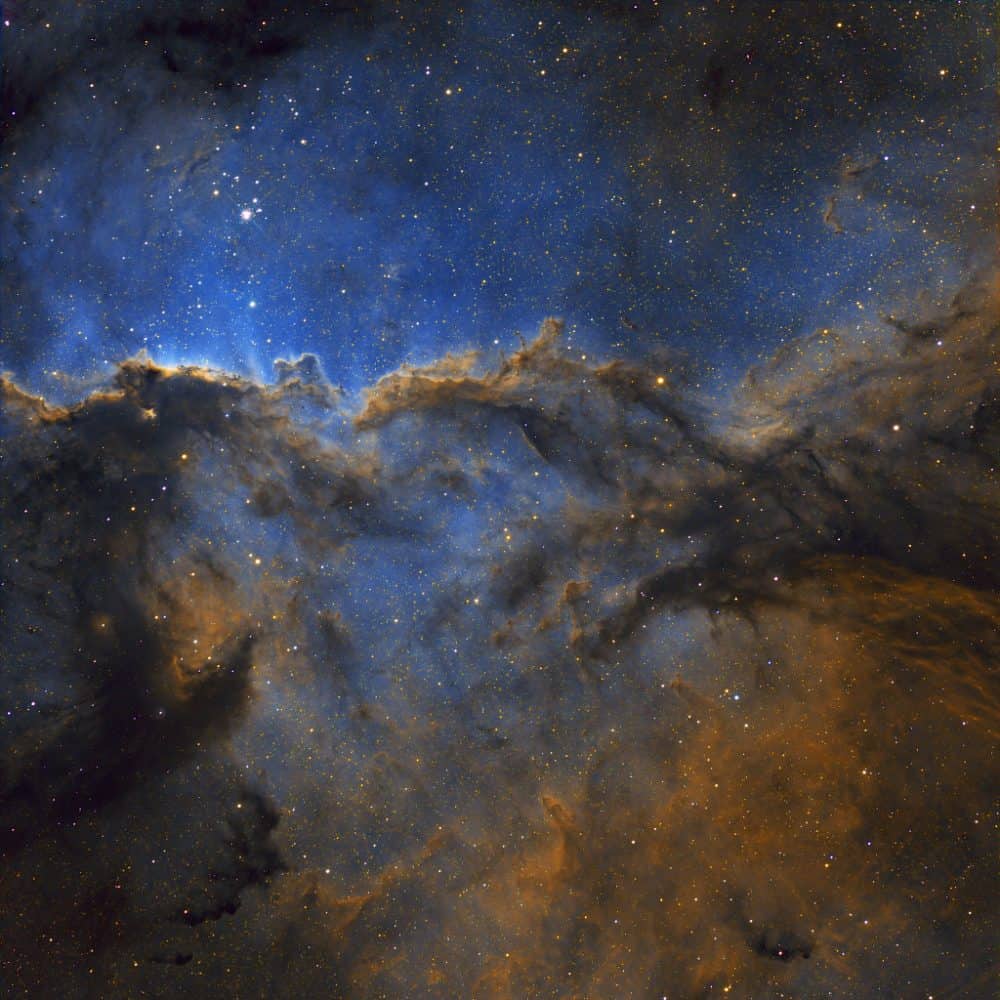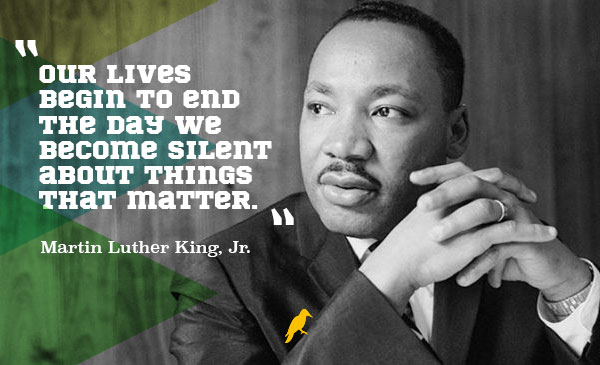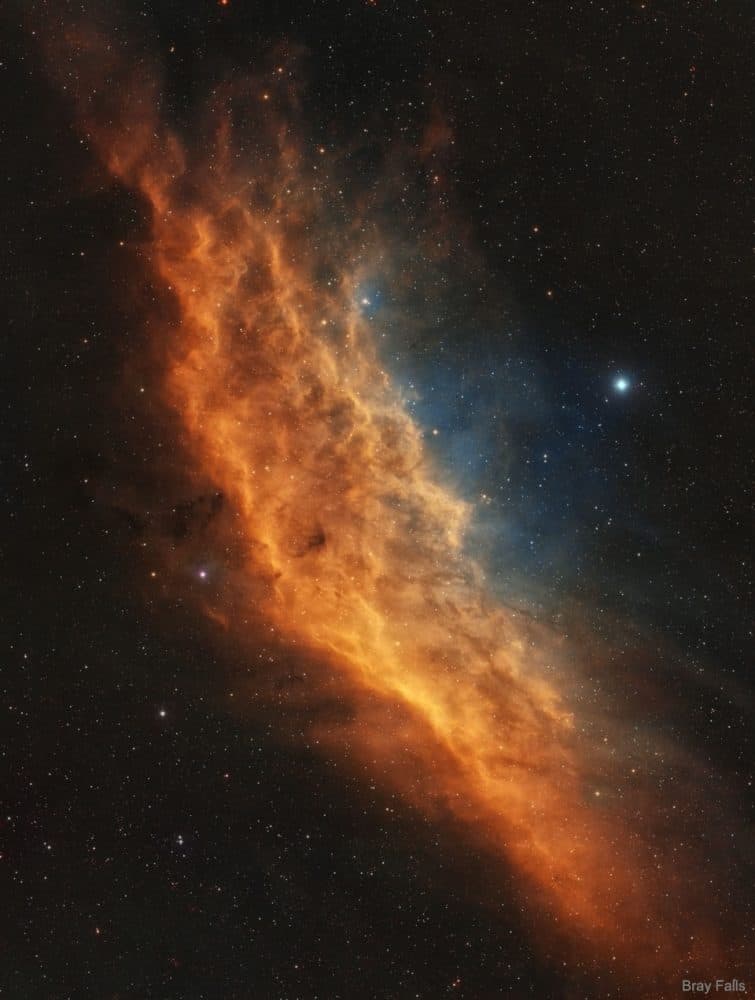Blog
Dark shapes with bright edges winging their way through dusty NGC 6188 are tens of light-years long. The emission nebula is found near the edge of an otherwise dark large molecular cloud in the southernconstellation Ara, about 4,000 light-years away. Born in that region only a few million years ago, the massive young stars of the embedded Ara OB1 association sculpt the fantastic shapes and power the nebular glow with stellar winds and intense ultraviolet radiation. The recent star formation itself was likely triggered by winds and supernova explosions, from previous generations of massive stars, that swept up and compressed the molecular gas. With image data from the Chilescope Observatory, a false-color Hubble palette was used to create this gorgeous wide-field image and shows emission from sulfur, hydrogen, and oxygen atoms in red, green, and blue hues. The field of view spans about four full Moons, corresponding to about 150 light years at the estimated distance of NGC 6188.
more...Roberta Joan Mitchell, CC (née Anderson; born November 7, 1943), professionally known as Joni Mitchell, is a Canadian singer-songwriter.Drawing from folk, pop, rock, and jazz, Mitchell’s songs often reflect social and environmental ideals as well as her feelings about romance, confusion, disillusionment, and joy. She has received many accolades, including nine Grammy Awards. Rolling Stone called her “one of the greatest songwriters ever”, and AllMusic has stated, “When the dust settles, Joni Mitchell may stand as the most important and influential female recording artist of the late 20th century”.
Mitchell began singing in small nightclubs in her hometown of Saskatoon, Saskatchewan, and throughout western Canada, before busking in the streets and nightclubs of Toronto, Ontario. In 1965, she moved to the United States and began touring. Some of her original songs (“Urge for Going”, “Chelsea Morning“, “Both Sides, Now“, “The Circle Game”) were covered by other folk singers, allowing her to sign with Reprise Records and record her debut album in 1968. Settling in Southern California, Mitchell, with popular songs like “Big Yellow Taxi” and “Woodstock“, helped define an era and a generation. Her 1971 album Blue is often cited as one of the best albums of all time; it was rated the 30th best album ever made in Rolling Stone‘s list of the “500 Greatest Albums of All Time“, the highest entry by a female artist. In 2000, The New York Times chose Blue as one of the 25 albums that represented “turning points and pinnacles in 20th-century popular music”. In 2017, NPR ranked Blue Number 1 on a list of Greatest Albums Made By Women.
Mitchell’s fifth album, For the Roses, was released in 1972. She then switched labels and began exploring more jazz-influenced melodic ideas, by way of lush pop textures, on 1974’s Court and Spark, which featured the radio hits “Help Me” and “Free Man in Paris“ and became her best-selling album.
https://www.youtube.com/watch?v=dUBbDe3DZ1M
more...David Spencer Ware (November 7, 1949 – October 18, 2012) was an American jazz saxophonist, composer, and bandleader.
David S. Ware was born in Plainfield, New Jersey, grew up in Scotch Plains, New Jersey, graduated from Scotch Plains-Fanwood High School, and briefly attended the Berklee College of Music. He moved to NYC in 1973, where he participated in the loft jazz scene, and later worked as a cab driver for 14 years in order to focus on his own group concept. In the early 1980s, he returned to Scotch Plains with his wife Setsuko S. Ware.
Ware’s debut album as a leader was recorded in 1977 – together with pianist Gene Ashton (aka Cooper-Moore) and drummer Marc Edwards – and released by HatHut in 1979. He performed and recorded with the groups of pianist Cecil Taylor and drummer Andrew Cyrille in the mid-late 1970s. He formed his own quartet in 1989. The group was originally composed of Ware, pianist Matthew Shipp, bassist William Parker, and drummer Marc Edwards. While Shipp and Parker were members for the group’s entire existence, the drum chair was later occupied by Whit Dickey, Susie Ibarra, and Guillermo E. Brown.
more...Joe Bushkin (November 7, 1916 – November 3, 2004) was an American jazz pianist.
Born in New York City, Bushkin began his career by playing trumpet and piano with New York City dance bands, including Frank LaMare’s Band at the Roseland Ballroom in Brooklyn. He joined Bunny Berigan‘s band in 1935, played with Eddie Condon from 1936-37, and with Max Kaminsky and Joe Marsala, before rejoining Berigan in 1938. He then left to join Muggsy Spanier‘s Ragtime Band in 1939. From the late 1930s through to the late 1940s he also worked with Eddie Condon on records, radio and television. After service in World War II he worked with Louis Armstrong, Bud Freeman and Benny Goodman.
He married Francice Netcher, elder sister of socialite Mollie Wilmot. The couple had four children – Nina, Maria, Terasa, and Christina. They lived in Santa Barbara, California, on a ranch.
His best-known composition might be “Oh! Look at Me Now“, with John DeVries, written when he worked in Tommy Dorsey‘s band. That song would become Frank Sinatra‘s first hit.
more...Drifting through the Orion Arm of the spiral Milky Way Galaxy, this cosmic cloud by chance echoes the outline of California on the west coast of the United States. Our own Sun also lies within the Milky Way’s Orion Arm, only about 1,500 light-years from the California Nebula. Also known as NGC 1499, the classic emission nebula is around 100 light-years long. On the featured image, the most prominent glow of the California Nebula is the red light characteristic of hydrogen atoms recombining with long lost electrons, stripped away (ionized) by energetic starlight. The star most likely providing the energetic starlight that ionizes much of the nebular gas is the bright, hot, bluish Xi Persei just to the right of the nebula. A regular target for astrophotographers, the California Nebula can be spotted with a wide-field telescope under a dark sky toward the constellation of Perseus, not far from the Pleiades.
more...Aurora “Rory” Block (born November 6, 1949, Princeton, New Jersey, United States) is an American blues guitarist and singer, a notable exponent of the country blues style.
Aurora Block was born in Princeton and grew up in Manhattan. Her father, Allan Block, ran a sandal shop in Greenwich Village in the 1960s, and the influence of the Greenwich Village folk music scene, such as Peter Rowan, Maria Muldaur, and John Sebastian,[1] tempted Block to study classical guitar. At the age of 14, she met guitarist Stefan Grossman, who introduced her to the music of Mississippi Delta blues guitarists. Block began listening to old albums, transcribing them, and learning to play the songs. At age 15, she left home to seek out the remaining blues giants, such as Mississippi John Hurt, Reverend Gary Davis, and Son House, and hone her craft in the traditional manner of blues musicians;[1] then she traveled to Berkeley, California, where she played in clubs and coffeehouses.
more...Arturo Sandoval (born November 6, 1949) is a Cuban American jazz trumpeter, pianist and composer.
Sandoval, while living in his native Cuba, was influenced by jazz musicians Charlie Parker, Clifford Brown, and Dizzy Gillespie, finally meeting Gillespie later in 1977. Gillespie became a mentor and colleague, playing with Sandoval in concerts in Europe and Cuba and later featuring him in the United Nations Orchestra. Sandoval defected while touring with Gillespie in 1990, and he became a naturalized citizen in 1998.
His life was the subject of the film For Love or Country: The Arturo Sandoval Story (2000), starring Andy García. Sandoval has won ten Grammy Awards and been nominated nineteen times; he has also received six Billboard Awards and one Emmy Award. Additionally, Sandoval has performed in a Super Bowl Halftime Show (1995), in an Orange Bowl (2009) at the White House, and at the University of Notre Dame.
On August 8, 2013, former President Barack Obama announced that Sandoval would receive the Presidential Medal of Freedom.
As a twelve-year-old boy in Cuba, Sandoval played trumpet with street musicians. He helped establish the Orquesta Cubana de Musica Moderna, which became the band Irakere in 1973. He toured worldwide with his own group in 1981. The following year he toured with Dizzy Gillespie, who became his friend and mentor. In 1989, Gillespie invited Sandoval to be part of the United Nations Orchestra. During a tour with this group, Sandoval visited the American Embassy in Rome to defect from Cuba. He became an American citizen on December 7, 1998.
https://www.youtube.com/watch?v=ImU2TjosRW4
more...IC 4592 (also known as the Blue Horsehead Nebula) is a reflection nebula in the Scorpius constellation that is lit by Nu Scorpii. 40 ly distance
What you are seeing is not the famous Horsehead nebula toward Orion but rather a fainter nebula that only takes on a familiar form with deeper imaging. The main part of the here imaged molecular cloud complex is a reflection nebula cataloged as IC 4592. Reflection nebulas are actually made up of very fine dust that normally appears dark but can look quite blue when reflecting the light of energetic nearby stars. In this case, the source of much of the reflected light is a star at the eye of the horse. That star is part of Nu Scorpii, one of the brighter star systems toward the constellation of the Scorpion (Scorpius). A second reflection nebula dubbed IC 4601 is visible surrounding two stars to the right of the image center.
more...Neil Cowley (born 5 November 1972) is a contemporary jazz pianist whose previous incarnations include Fragile State, the Green Nuns of the Revolution, and the Neil Cowley Trio, which appeared on Later… with Jools Holland in April 2008 and won the 2007 BBC Jazz Award for best album for Displaced.
Cowley was born in London. He began as a classical pianist and performed a Shostakovich piano concerto at the age of 10 at Queen Elizabeth Hall. In his late teens Cowley moved into being a keyboardist for soul and funk acts Mission Impossible, the Brand New Heavies, Gabrielle and Zero 7. He also appeared as a co-composer and session musician with the jazz-rock group Samuel Purdey. An early album was “Foxbury Rules”, released under the pseudonym Diamond Wookie.
more...Arthur Ira Garfunkel (born November 5, 1941) is an American singer, poet, math teacher and actor. He is best known for his partnership with Paul Simon in the folk rock duo Simon & Garfunkel.
Highlights of his solo music career include a top 10 hit, three top 20 hits, six top 40 hits, 14 Adult Contemporary top 30 singles, five Adult Contemporary number ones, two UK number ones and a People’s Choice Award. Through his solo and collaborative work, Garfunkel has earned eight Grammys, including a Lifetime Achievement Award. In 1990, he and Simon were inducted into the Rock and Roll Hall of Fame.
Garfunkel was born in Forest Hills, Queens, New York City, the son of Rose (née Pearlman) and Jacob “Jack” Garfunkel, a traveling salesman. Art is a middle child with two brothers, the older named Jules and the younger named Jerome. Jacob’s parents had originally emigrated to the United States at the turn of the century, and settled in Manhattan. Before his career in sales, Jacob worked as an actor in Dayton, Ohio. Garfunkel is Jewish; his paternal grandparents immigrated from Iași in Romania. His maternal cousin was Lou Pearlman.
https://www.youtube.com/watch?v=ucT-2YJslt8
more...https://www.youtube.com/watch?v=LBK7_DYxkpw
more...In the northern constellation of Coma Berenices (Berenice’s Hair) lies the impressive Coma Cluster — a structure of over a thousand galaxies bound together by gravity. Many of these galaxies are elliptical types, as is the brighter of the two galaxies dominating this image: NGC 4860 (centre). However, the outskirts of the cluster also host younger spiral galaxies that proudly display their swirling arms. Again, this image shows a wonderful example of such a galaxy in the shape of the beautiful NGC 4858, which can be seen to the left of its bright neighbour and which stands out on account of its unusual, tangled, fiery appearance. NGC 4858 is special. Rather than being a simple spiral, it is something called a “galaxy aggregate”, which is, just as the name suggests, a central galaxy surrounded by a handful of luminous knots of material that seem to stem from it, extending and tearing away and adding to or altering its overall structure. It is also experiencing an extremely high rate of star formation, possibly triggered by an earlier interaction with another galaxy. As we see it, NGC 4858 is forming stars so frantically that it will use up all of its gas long before it reaches the end of its life. The colour of its bright knots indicates that they are formed of hydrogen, which glows in various shades of bright red as it is energised by the many young, hot stars lurking within. This scene was captured by the NASA/ESA Hubble Space Telescope’s Wide Field Camera 3 (WFC3), a powerful camera designed to explore the evolution of stars and galaxies in the early Universe.
NGC 4860 is an elliptical galaxy in the constellation Coma Berenices. The galaxy was discovered on 21 April 1865 by Heinrich Louis d’Arrest.
With its distance from earth being approximately 110 million parsecs, NGC 4860 belongs to the Coma Cluster, which consists of over 1,000 identified galaxies
more...Jeffrey H. Lorber (born November 4, 1952) is an American keyboardist, composer, and record producer. After six previous nominations, Lorber won his first Grammy Award on Jan. 28, 2018 for Best Contemporary Instrumental Album for Prototype by his band The Jeff Lorber Fusion.
Many of his songs have appeared on The Weather Channel‘s Local on the 8s segments and on the channel’s compilation albums, The Weather Channel Presents: The Best of Smooth Jazz and The Weather Channel Presents: Smooth Jazz II. He was nominated for a Grammy Award for his album He Had a Hat (Blue Note, 2007)
Lorber was born to a Jewish family in Cheltenham, Pennsylvania, the same suburb as Michael and Randy Brecker, with whom he would later play.He started to play the piano when he was four years old. After playing in a number of R&B bands as a teen, he attended Berklee College of Music, where he developed his love for jazz.
more...More Posts
- World Music with Aynur Doğan
- Daily Roots with Aisha
- The Cosmos with IC 1396
- Alice Coltrane
- Lester Young
- Flamenco Fridays with Jośe Galván, Arcángel y Rafael Rodríguez
- Daily Roots with Junior Marvin
- The Cosmos with M17
- Branford Marsalis
- Leon Redbone
- Virgil Jones
- World Music with Monoswezi
- Daily Roots with Tommy Clarke
- Charlie Watts Memorial
- Rhythm Roots Workshop
- The Cosmos with NGC 2264
- Linda May Han Oh
- Pat Martino
- Wayne Shorter
- Leonard Bernstein




